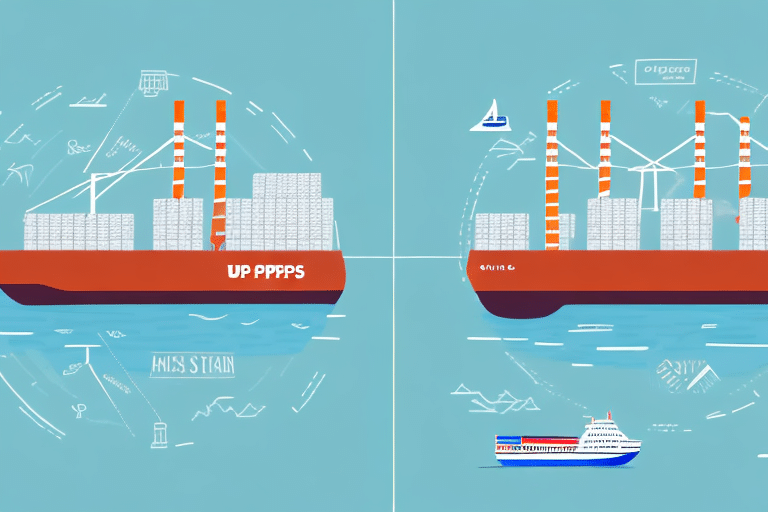Understanding the Relationship Between UPS and USPS
When it comes to shipping, two major players dominate the landscape: UPS and USPS. Each has its unique strengths and weaknesses, offering a wide range of services to consumers and businesses alike. This article delves into the relationship between these shipping giants, exploring their services, history, collaborations, pricing, and customer experiences to help you make informed shipping decisions.
Comparing Services Offered by UPS and USPS
Domestic Shipping Options
Both UPS and USPS provide a variety of shipping options within the United States, including next-day, 2-day, and ground shipping services. UPS primarily caters to corporate and larger businesses, offering extensive logistics and supply chain solutions. In contrast, USPS focuses more on consumer-oriented services, such as Priority Mail, Media Mail, and Retail Ground.
International Shipping Capabilities
When it comes to international shipping, UPS boasts a more expansive global network, providing comprehensive options like air, ocean, and ground transportation. USPS offers international services through Priority Mail International and First-Class Mail International, but its global reach is more limited compared to UPS.
Pricing Structures
Pricing for UPS and USPS services varies based on factors such as package weight, destination, and shipping speed. Generally, UPS tends to be more expensive due to its extensive service offerings and reliable tracking. USPS, however, often provides more cost-effective solutions, especially for smaller packages and less urgent deliveries.
For a detailed comparison of shipping rates, you can refer to the official UPS Rate Calculator and the USPS Rate Calculator.
The History and Growth of UPS and USPS
UPS: From Messenger Service to Global Logistics Leader
Founded in 1907 in Seattle, Washington, UPS began as a messenger company. Through strategic acquisitions and continuous expansion, UPS has evolved into a global logistics powerhouse. A key to its growth has been a focus on innovation, such as the introduction of consolidated delivery in the 1920s, which enhanced efficiency and reduced costs.
USPS: Serving America Since 1775
The USPS traces its origins back to 1775 when Benjamin Franklin was appointed the first Postmaster General. Over centuries, USPS has adapted to changing customer needs and technological advancements. Innovations like Informed Delivery, which allows customers to preview their mail and packages online, highlight USPS's commitment to modernizing its services.
Collaboration Between UPS and USPS
UPS SurePost Partnership
Despite being competitors, UPS and USPS collaborate through services like UPS SurePost. This partnership enables UPS to handle long-haul transportation, while USPS manages the final delivery. This collaboration helps both companies reduce costs and offer more affordable shipping options to customers.
Mail Innovations Service
Another collaborative effort is the "Mail Innovations" service, where businesses send large volumes of mail or packages via UPS to USPS for final delivery. This service streamlines the shipping process and can lead to significant cost savings for businesses.
However, it's important to note that services like UPS SurePost have limitations, such as package weight and size restrictions. Additionally, delivery times may be longer compared to standalone UPS or USPS services.
Pricing Comparison Between UPS and USPS
Cost Factors
The cost of shipping with UPS versus USPS depends on various factors including package weight, dimensions, destination, and desired delivery speed. Generally, UPS is more expensive due to its extensive service network and reliability, while USPS often offers more economical rates for smaller or less urgent packages.
Flat-Rate and Specialized Options
USPS provides flat-rate shipping options, such as Priority Mail Flat Rate boxes, which can be a great value for heavier items. UPS offers specialized services like UPS Ground, UPS 3 Day Select, and UPS Next Day Air, catering to different shipping needs.
For accurate pricing based on your specific needs, utilize the UPS Rate Calculator and the USPS Rate Calculator.
Tracking and Delivery Experience
Tracking Capabilities
Both UPS and USPS offer package tracking, but the level of detail varies. UPS provides comprehensive tracking information, including real-time updates and notifications via text or email. USPS offers basic tracking with updates on the package's current location and expected delivery date.
Delivery Reliability
UPS is often praised for its reliable and timely deliveries, especially for time-sensitive shipments. USPS handles a high volume of packages, which can sometimes lead to delays, particularly during peak seasons like holidays.
Customer Service and Satisfaction
UPS Customer Service
UPS is known for its proactive and personalized customer service. Customers can access support through various channels, including phone, email, and live chat, and often receive prompt assistance with their queries and issues.
USPS Customer Service
USPS provides customer service through its website, phone support, and local post offices. While generally reliable, some customers report slower response times and less personalized interactions compared to UPS.
Technological Innovations Impacting UPS and USPS
Advanced Tracking Systems
Both UPS and USPS have integrated advanced tracking systems to enhance the shipping experience. UPS's tracking system offers detailed, real-time updates, while USPS continues to improve its tracking accuracy and speed.
Automation and Robotics
Automation plays a significant role in both companies’ operations. UPS utilizes automated sorting facilities and route optimization software to streamline deliveries. USPS has implemented automated package sorting machines and is exploring the use of drones for delivery in remote areas.
Conclusion: Choosing Between UPS and USPS for Your Shipping Needs
Deciding between UPS and USPS depends on your specific shipping requirements. UPS is ideal for businesses needing reliable, fast, and comprehensive shipping solutions, especially for international deliveries. USPS is a cost-effective choice for individuals and businesses sending smaller or less urgent packages domestically.
In many cases, utilizing both services can optimize your shipping strategy, allowing you to leverage the strengths of each provider based on your unique needs. Always consider factors like cost, delivery speed, package size, and destination when choosing the best shipping carrier for your requirements.
For more insights and detailed comparisons, refer to reputable sources such as the Business Insider UPS vs USPS Comparison and the The Balance UPS vs USPS Guide.






















